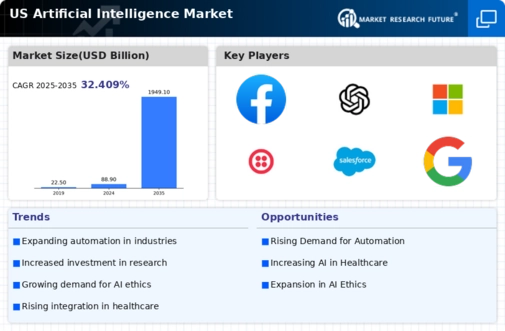Regulatory Support for AI in Education
Regulatory support for the integration of AI in education is emerging as a significant driver in the artificial intelligence-education market. Policymakers are recognizing the potential of AI technologies to enhance educational outcomes and are implementing frameworks to support their adoption. Recent initiatives have been launched to promote the responsible use of AI in educational settings, ensuring that ethical considerations are addressed. This regulatory environment is fostering confidence among educational institutions to invest in AI solutions. As a result, the artificial intelligence-education market is likely to experience accelerated growth, with institutions increasingly adopting AI tools to improve teaching and learning processes. The alignment of regulatory support with technological advancements is creating a conducive environment for innovation in education.
Growing Demand for Data-Driven Insights
The demand for data-driven insights in education is propelling the artificial intelligence-education market forward. Educational institutions are increasingly relying on AI analytics to make informed decisions regarding student performance and curriculum effectiveness. Approximately 70% of schools are utilizing AI tools to analyze student data, enabling them to identify trends and improve educational outcomes. This reliance on data analytics is fostering a culture of continuous improvement within educational settings. As institutions seek to enhance their operational efficiency and student engagement, the artificial intelligence-education market is likely to expand, with a projected growth rate of 25% annually. The ability to harness data effectively is becoming a critical factor for success in the education sector.
Increased Investment in EdTech Startups
Investment in educational technology startups is a key driver of growth in the artificial intelligence-education market. Venture capital funding for EdTech companies has surged, with investments reaching approximately $3 billion in 2025 alone. This influx of capital is fostering innovation and the development of AI-based educational tools that enhance learning outcomes. Investors are particularly interested in startups that leverage AI to provide scalable solutions for personalized learning, assessment, and administrative tasks. The competitive landscape is evolving, as established companies and new entrants alike strive to capture market share. This trend not only accelerates technological advancements but also contributes to the overall expansion of the artificial intelligence-education market, which is projected to continue its upward trajectory in the coming years.
Focus on Lifelong Learning and Upskilling
The emphasis on lifelong learning and upskilling is driving the artificial intelligence-education market as individuals seek to adapt to the rapidly changing job landscape. With the rise of automation and AI technologies, there is a growing need for continuous education and skill development. Organizations are increasingly investing in AI-driven training programs to equip their workforce with the necessary skills for the future. This trend is reflected in the fact that 40% of companies are implementing AI-based learning solutions to facilitate employee training. As the workforce evolves, the artificial intelligence-education market is expected to grow, with a focus on providing accessible and flexible learning opportunities for professionals seeking to enhance their skill sets.
Integration of AI in Curriculum Development
The integration of artificial intelligence in curriculum development is transforming the educational landscape. Educational institutions are increasingly adopting AI technologies to create personalized learning experiences tailored to individual student needs. This trend is evident as 60% of educators report using AI tools to enhance lesson planning and content delivery. The artificial intelligence-education market is witnessing a surge in demand for AI-driven platforms that facilitate adaptive learning, enabling students to progress at their own pace. Furthermore, the incorporation of AI in curriculum design allows for real-time data analysis, helping educators identify learning gaps and adjust instructional strategies accordingly. As a result, the artificial intelligence-education market is expected to grow significantly, with projections indicating a market value exceeding $10 billion by 2027.
























Leave a Comment